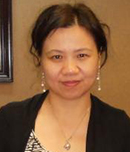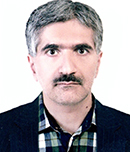Day 1 :
Keynote Forum
Colin McMartin
ThistleSoft High Meadow
USA
Keynote: A Set of Diagnostic Bench Tests Leads to the Development of Accurate Flexible Docking Algorithms
Time : TBD

Biography:
Dr. Colin McMartin has completed his Degree in Chemistry from Cambrige University, England in 2012. Curently he is a CEO of Thistlesoft
Abstract:
An X-ray based geometry force field (1, 2) was applied to PDB data to produce a consistent set of 11, 03 all atom binding site models. Geometries are conserved in regions with sharp electron density, elsewhere small movements lead to geometries and energies found at atomic resolution.
These models contain multiple complexes for 3,900 unique proteins and are a rich source of information on ligand-induced binding site changes.
The data is split into learning sets which focus on different challenges to docking prediction:
1) Flexible ligand - fixed site
2) Ligand dependent water bridging
3) Predicting side-chain movement
These bench tests can detect and track docking errors. Examination of 3D-images of docked/target poses is also helpful.
Results
These tests are being successfully used to develop new algorithms for QXP (2).
1) Tests for flexible ligand docking suggested changes which result in large increases in successful predictions (rms to experimental <0.3 A).
2) Addition of bridging water improved the numbers of accurate predictions. The algorithm for computing water coordinates was based on the X-ray force field and atomic resolution
X-ray data.
3) Side-chain movement: A data base of pairs of structures suitable for cross-docking has been developed. Preliminary results of cross-docking studies will be reported.
Keynote Forum
Victor J. Hruby
University of Arizona
USA
Keynote: CONFORMATIONAL AND DYNAMIC CONSIDERATIONS IN DRUG DESIGN FOR G-PROTEIN COUPLED RECEPTORS
Time : TBD

Biography:
Dr. Victor J. Hruby is a Regents Professor in the Department of Chemistry and Biochemistry at the University of Arizona. He received his PhD at Cornell University in Theoretical Organic Chemistry and did a Postdoctoral studies with Nobel Laureate Vincent du Vigneaud. He has been a professor at University of Arizona since 1968 where he has joint appointments in the Neuroscience Program, Medical Pharmacology, and Bio5 among others. Dr. Hruby’s research interests are in the chemistry, biophysics, molecular pharmacology, molecular biology of peptide hormones and neurotransmitters and their receptors, transduction systems and in the design, synthesis and bio evaluation of novel ligands for the treatment of degenerative diseases.
Abstract:
Most natural ligands for G-Protein Coupled Receptors are peptides, and most of these peptides are linear peptides with multiple conformations in aqueous solution. There are good biological reasons for this, not the least of which is that different conformations are utilized during their biological life. However, they require a specific conformation for their interaction with their membrane bound receptors. Moreover, many of these hormones and neurotransmitters can interact with several receptor subtypes and virtually all native ligands are agonists. For drug design, it often is necessary to design ligands that are highly receptor selective, and often both agonists and antagonists are needed for various medical and biological applications. We have been developing a strategy to deal with the above drug design requirements which includes the following: 1) determining the basic pharmacophore; 2) discovering antagonists; 3) computer assisted homology modeling of receptor ligand interactions for receptor selectivity and agonist vs. antagonist efficacy; 4) conformation constraint by novel cyclization, backbone modification and chi space constraints; 5) monovalent and multivalent ligands depending upon biological and medical application; 6) enhanced bioavailability including blood brain penetration or not. We will illustrate these strategies in the design of ligands for the treatment of prolonged and neuropathic pain, pigmentary disorders, sexual dysfunction and cancer, as time permits.
Supported in part by grants from the U.S. Public Health Service and National Institutes of Health
Keynote Forum
Carsten Detering
BioSolveIT Inc
USA
Keynote: Digging in untapped chemical space: How to combine novelty and synthetic access
Time : TBD

Biography:
Dr. Carsten Detering obtained his PhD in Physical Chemistry from the Freie Universitaet Berlin in Germany in 2001. He did his Post Doc at the University of Washington in Seattle where he worked on the application of docking software for nucleic acid drug targets and rational design of new inhibitors for a malaria project. In 2005 he came to BioSolveIT in Germany as an Application Scientist first, later filling the position of Senior Key Account Manager and Executive VP of Sales, North America, before moving back to Seattle as CEO of BioSolveIT Inc, the North American subsidiary of BioSolveIT
Abstract:
No matter how big your in-house library and no matter how many compounds you acquire as supplement, it merely scratches the surface of what chemists are capable of synthesizing. While all that it takes is capturing chemical reactions in a computer-readable fashion. Consider as an example a combinatorial synthesis protocol for the discovery of novel CDK2 inhibitors. The original Science publication by Gray et al. reports 19 reagents for R1, 7 for R2, and 10 for R3 resulting in 19 x 7 x 10 = 1,330 products. Sensibly extended reagent lists with commercially available primary amines and alcohols leads to roughly 70 million compounds for this single reaction protocol. Similarly we collated many more protocols for a number of targets and also including some purely chemistry-driven libraries, which now constitutes a Chemical Space of hundreds of billions of virtual compounds with high likelihood of straight forward synthetic access. We make this literature-derived collection publicly available and also provide a unique similarity search method capable to explore such wealth of data. Imagine de novo design of (a) hit expansion libraries, (b) follow-up series and (c) fragment evolution designs from within an all accessible compound space. We will demonstrate how this can become reality
Keynote Forum
Simone V. Bigi
Takeda California, Inc., USA
Keynote: Exploiting Unique Interactions in the MKK3/6 and ASK1 Kinase Active Sites through Computer-Aided Drug Design

Biography:
Simone Bigi completed her B.S. from the University of Notre Dame in South Bend, Indiana
Abstract:
Since the early 1990’s, the concept of structure-based drug design has been demonstrated on a wide array of protein targets, becoming an established and integral part of drug discovery and lead optimization. While now synonymous with this concept, computer-aided modeling is widely recognized as a seminal aspect of structurally enabled drug discovery programs. The ubiquitous exposure to structural information has spawned a scientific enlightenment around the details and nuances of protein structural information.
Kinases are one of the most extensively studied protein families based on the vast number of structures currently available in the Protein Data Bank. Although they share similar architectures and substrates, it is still quite common to identify unique interactions within these proteins that can yield highly selective inhibitors. My talk will describe the use of computer-aided drug design in the context of optimizing novel inhibitors of the two kinases: MAP Kinase Kinase isoforms 3/6 (MKK3/6) and the Apoptosis Signal-Regulating Kinase 1 (ASK1). Each of these kinases is found within the MAPK pathway and contain unique residues and interactions in the active site. Using structure-based modeling, these differences were exploited to enhance inhibitor potency and selectivity. These efforts yielded highly efficient and selective tool compounds that were valuable in testing key pharmacological hypotheses in the areas of immunological and cardiovascular diseases.
Keynote Forum
Thorsten Nowak
C4X Discovery
UK
Keynote: Ligand conformational analysis enabling improved Nrf2 activators
Time : TBD

Biography:
Thorsten Nowak completed his PhD from the University of Cambridge (UK) in the areas of aldol methodology and natural product synthesis. In 1996 he joint AstraZeneca where he worked on all stages of drug discovery from target to candidate selection in medicinal chemistry as team leader and project manager. His keen interest in new technologies motivated a career move from big pharma to platform technology business in 2012 when he joint C4X Discovery. In his current role he is responsible for all internal drug discovery projects at C4X Discovery as well as continued development of the technology in the context of application to drug discovery.
Abstract:
Chronic Obstructive Pulmonary Disease (COPD) is an area of substantial unmet medical need. In particular, effective anti-inflammatory therapy is required in addition to bronchodilator therapy as disease severity progresses. While oral PDE4 inhibitors are currently used for this purpose and have been shown to be effective on exacerbation rates, their degree of efficacy is disappointing. In this regard, Nrf-2 activators have the potential to be efficacious on exacerbation rate with much a better tolerability profile. However, it has been difficult to create highly potent drug-like non-covalent inhibitors for the key Nrf2/Keap-1 protein-protein interaction (PPI).
Nrf2 is a master regulator of the cell’s antioxidant response and its activation leads to a coordinated antioxidant and anti-inflammatory response. Here we present a detailed 3D-structural analysis of a publicly available Nrf2 activator [1], which functions by blocking the interaction of Nrf2 with its repressor Keap-1.
The variety of conformations that the free activator adopts in solution was precisely measured using the NMR methodology of Blundell et al [2] and this data was combined with results from protein X-ray co-crystallography and in silico docking. The synergistic combination of these techniques provides unique insights into the disruption of this protein-protein interface, and demonstrates the power of combining ligand-based and structure-based drug design approaches. These data provide clear, immediate and rational strategies for both conventional and conformational design of the ligand to achieve improved potency.
Keynote Forum
Concepción González-Bello
Universidade de Santiago de Compostela
Spain
Keynote: Targeting the Motion of Shikimate Kinase – Opportunities for Antibiotic Drug Development
Time : TBD

Biography:
Concepción González-Bello has obtained her PhD at the University of Santiago de Compostela (USC, Spain) in 1994. She did two predoctoral stays in the University of Gent (Belgium) with Prof. Vandewalle and in the Scripps Research Institute (USA) with Prof. Nicolaou. After a postdoctoral stay in the University of Cambridge (UK) with Prof. Abell, she joined USC as an Assistant Professor, was promoted to Associate Professor in 2003 and obtained the Spanish habilitation to full Professor in 2011. She joined the Center for Research in Biological Chemistry and Molecular Materials (CIQUS) as a group leader in 2011. She is author of more than 70 papers and several book chapters. She is a member of the ChemMedChem International Advisory Board and an Academic Editor of PLOS ONE. Her main research interest is to develop updated therapies targeting infectious diseases, in particular, drugs with new mechanisms of action to combat the growth of antibiotic-resistant bacteria.
Abstract:
The increasing development and spread of resistance to current antibiotics have turned ordinary bacterial infections into illnesses that cannot be controlled. Infections from resistant bacteria are now too common and some pathogens have even become resistant to multiple types of antibiotics. Therefore, it is urgent to search for new antibacterial agents and approaches to face the challenge of multidrug resistance. The disruption of the growth cycle by preventing the synthesis and assembly of key components of bacterial processes is the most widely used strategy to combat bacterial infections. Most current antibiotics that are highly successful in human clinical use, surprisingly targeted at only four main key processes and resistance to these antibiotics is widespread and well known. Therefore, the search for unexplored bacterial functions appears to be a good option for the development of novel antimicrobial agents with a new mechanism of action. For this purpose, our research group is studying the possible development of new antibiotics whose mode of action is based on the selective and effective inhibition of an essential enzyme in bacteria that does not have any counterpart in human cells, shikimate kinase (SK). This enzyme is essential in relevant pathogenic bacteria such as Mycobacterium tuberculosis, Helicobacter pylori and Pseudomonas aeruginosa. The starting point for our inhibitors design was the study of: (a) the substrate binding requirements, (b) the phosphoryl-transfer mechanism and (c) the essential enzyme motions for product release. Here we report results from NMR, biochemical, structural and Molecular Dynamics simulation studies that help understand the catalytic mechanism, the binding requirements and the essential enzyme motions for product release of the SK enzyme. Based on these results, potent reversible competitive inhibitors of the enzyme were developed. An ester prodrug approach was used for achieving good in vitro activities against H. pylori. Our recent results on this project will be presented
Keynote Forum
Tatsuya Takagi
Osaka University
Japan
Keynote: In silico analysis of enantioselective binding of IMiDs to cereblon
Time : TBD

Biography:
Tatsuya TAKAGI has completed his Ph.D. at the age of 32 from Osaka University. At that time, he had been an Assistant Professor of School of Pharmaceutical Sciences, Osaka University for 5 years. Then, since 1993, he had worked for the Genome Information Research Center, Osaka University as an Associate Professor until he became a professor of Graduate School of Pharmaceutical Sciences, Osaka University in 1998. He has published more than 100 papers in reputed journals and serving as Chairman of Division of Structure-Activity Relationship of the Pharmaceutical Society of Japan
Abstract:
Thalidomide and its analogs, lenalidomide and pomalidomide (referred to as immunomodulatory drugs or IMiDs) have been known to treat multiple myeloma and other hematologic malignancies as well as to cause teratogenicity. Recently the protein, named cereblon, was identified as the primary target of IMiDs, and crystallographic studies of the cereblon-IMiD complex showed strong enantioselective binding for the (S)-enantiomer of IMiDs. Here, using the structures of cereblon and IMiDs (both (S)-enantiomers and (R)-enantiomers), we performed docking simulations in order to replicate this enantiomeric selectivity and to identify the region(s) contributing to this selectivity. We confirmed the enantioselective binding of IMiDs to cereblon with high accuracy, and propose that the hairpin connecting the β10-β11 region of cereblon (residues 351-355) contributes to this selectivity and to the increased affinity with IMiDs. Our docking results provide novel insights into the binding mode of IMiDs-like molecules and contribute to a deeper understanding of cereblon-related biology.
Keynote Forum
Regine Bohacek
Boston De Novo Design
USA
Keynote: “Growing†Hydrogen Bonding Waters in Molecular Complexes
Time : TBD

Biography:
Regine S. Bohacek is founder and owner of Boston Denovo.com and has published extensively in the field of computational chemistry with a particular interest in de novo methods and structure based design
Abstract:
The goal of this work is to use fast algorithms from the denovo design program, AlleGrow (1), to accurately position explicit waters in a protein structure. The best source of precise data on water interactions in organic complexes is found in small molecule X-ray structures. The studies were done using packed X-ray structures which contain water taken from the Crystallographic Open Data
Base (COD, 2).
To test the growth algorithm, waters were removed one at a time and “regrown”. This search algorithm was optimized to ensure that the output contained water close to the experimental X-ray water. A scoring function was developed to rank order the water positions found in the search with the aim of identifying the water closest to the X-ray structure. The scoring function was optimized to obtain the best possible predictions for a large set of different experimental waters.
Keynote Forum
Marc Le Borgne
University Lyon 1
France
Keynote: Indeno[1,2-b]indoles: a good scaffold for designing bioactive molecules
Time : TBD

Biography:
Marc Le Borgne has completed his PhD at the age of 31 years from Nantes Atlantic University after Pharmacy studies (6 years). He is the director of EA 4446 B2MC, a research group dedicated to Drug Design, Synthesis and Structural Optimization. He has published more than 60 papers in reputed journals and is serving as an editorial board member of Pharmaceuticals (since 2016). He gave some invited lectures abroad (Saarbrück, Duesseldorf, Oslo, Tromsø, Bergen, Debrecen, Sacramento, Helsinki, Oulu...). He is developing bioactive small molecules targeting kinases, efflux pumps and CYPs
Abstract:
Indeno[1,2-b]indoles represent an important class of synthetic compounds for exploring drug targets. The great interest of these structures in Drug Design is due to the use of various building blocks to get the elemental four ring structure. Depending on the synthetic route chosen, the medicinal chemists can also achieve a large number of pharmacomodulations. Therefore, this presentation aims (i) to present an overview on how to access this family of heterocyclic compounds and (ii) to discuss their various biological applications in oncology (e.g. protein kinases and phosphatases) and in chemoresistance (e.g. ABC transporters). New biological investigations will be also presented.
Exploration of protein kinase CK2 by a functionalized indeno[1,2-b]indole

The presentation will cover several scientific disciplines to highlight our drug discovery programme dedicated to indeno[1,2-b]indoles. For example, organic syntheses (classical chemical process, “greener” methods), structural optimizations, CE-assay, Autodisplay technology, crystallography, docking, SAR and 3D-QSAR studies, rational design, complexation studies of cyclodextrins, cytotoxicity studies and so on will be presented and discussed.
The audience could notice how a research project started, made progress and allowed to build a ChemBio partners' network to share knowledge and results. Furthermore the success will depend on how chemists interfere with biologists. Both must investigate in all areas at the interface of chemistry and biology
- Mastering Medicinal Chemistry
Chair
sfdbsab
ASDb
Session Introduction
Minying Cai
Arizona Cancer Center
USA
Title: Design of novel potent and selective agonists at the melanocortin1 receptor

Biography:
Minying Cai is currently a research professor in the Department of Chemistry and Biochemistry at the University of Arizona. She has been working in the Chemistry & Biochemistry department for more than 16 years and has more than 100 publications in the area of novel drug discovery for obesity, diabetes, cancer and pain. She received the Ph.D. at the University of Arizona in Biochemistry and Molecular Biophysics in 2004. Before that, she had been working in Shanghai Institute of Materia Medica; Shanghai Research Center of Biotechnology in Chinese Academy of Sciences.
Abstract:
Melanoma is a lethal form skin cancer which causes more than 10,000 deaths in the United States annually. Skin pigmentation, which is regulated by the melanocortin 1 receptor (MC1R), is an effective protection against melanoma. However, the endogenous MC1R agonists and some of its analogues lack selectivity to MC1R and can have side effects through other melanocortin receptors. Here we report the development of potent and selective hMC1R agonists using state of computational chemistry combined with chimeric receptor studies. We successfully developed a potent selective hMC1R selective agonist with at least 100/300/15-fold selectivity towards hMC3R/hMC4R/hMC5R respectively. The binding affinity for the novel peptides is 25 nM. Key interactions between this peptide and hMC1R were identified through NMR studies and molecular docking studies. The bioavailability studies reveal that this novel peptide is an ideal peptide ligand for the melanoma prevention.
Eko Aditya
Vrije Universiteit Amsterdam
The Netherlands
Title: Molecular dynamics study of autotaxin with potential allosteric inhibitors

Biography:
Eko Aditya Rifai is currently a PhD student in Computational Toxicology at Vrije Universiteit Amsterdam, after pursuing his Bachelor’s and Master’s degrees at Universitas Indonesia and University of Glasgow, respectively. His research interests are using computational methods to discover potential inhibitors of enzymes correlating in human diseases and to examine interactions of drug candidates with target and off-target proteins.
Abstract:
Autotaxin is an enzyme catalyzing the synthesis of lysophosphatidic acid, a lipid signaling molecule involved in several cellular responses such as cellular survival, proliferation, differentiation, and migration. Nevertheless, abnormal expression of autotaxin is correlated with numerous cancer and fibrosis, therefore autotaxin is considered as drug target over years. All of currently studied autotaxin inhibitors bind in the orthosteric site of autotaxin. However, developing allosteric inhibitors can be valuable based on pharmacological aspects, such as more target-specific and cause less side effects. In this work, dynamics of autotaxin in free form and in complex with six ligands are studied by using molecular dynamics approach in order to observe the effect of allosteric binding to orthosteric site. As a result, four of six ligands found to affect the positions of orthosteric site significantly.

Biography:
Manjinder Singh is a Ph.D. research scholar in the Department of Pharmaceutical Sciences and Drug Research, Punjabi University, Patiala under the supervision of Dr. Om Silakari (Assistant Professor). He has completed his M. Pharmacy in the same department (2010–2012). His area of specialization is synthesis and biological evaluation of medicinal and organic compounds against Alzheimer’s diseases. He has about 08 publications under his credit on Flavones, Acetylcholinesterase, P2X7, kinase inhibitors like Syk, ZAP-70. He is working as a Senior Research Fellow of ICMR, Delhi in Department of Pharmaceutical Sciences and Drug Research, Punjabi University, Patiala.
Abstract:
Development of Multi-Target Directed Ligands (MTDLs) has emerged as a promising approach for targeting complex pathophysiology of Alzheimer’s disease (AD). Following this approach, a new series of 2-phenyl-1-benzopyran-4-one derivatives was designed, synthesized and biologically evaluated as inhibitors of acetylcholinesterases (AChEs), advanced glycation end products formation (AGEs) and also for their radical scavenging activity. The in vitro studies showed that the majority of synthesized derivatives inhibited acetylcholinesterase (AChE) with IC50 values in the nanomolar range. Among them, inhibitors 7h, 7k and 7a, strongly inhibited AChE, with IC50 value of 6.33, 7.56 and 11.0 nM, respectively, and were more potent than the reference compound donepezil. Moreover, the molecular docking study displayed that most potent compounds simultaneously bind to catalytic active site and peripheral anionic site of AChE. Besides, these compounds also exhibited greater ability to inhibit advanced glycation end products formation with additional radical scavenging property. Thus, 2-phenyl-1-benzopyran-4-one derivatives might be the promising lead compound as potential poly-functional anti-Alzheimer’s agents.
- Novel Drug Design
Session Introduction
Thorsten Nowak
C4X Discovery Manchester
UK
Title: Conformational design in medicinal chemistry - An important under-utilised opportunity

Biography:
Thorsten Nowak completed his PhD from the University of Cambridge (UK) in the areas of aldol methodology and natural product synthesis. In 1996, he joined AstraZeneca where he worked on all stages of drug discovery from target to candidate selection in medicinal chemistry as team leader and project manager. His keen interest in new technologies motivated a career move from big pharma to platform technology business in 2012 when he joined C4X Discovery. In his current role, he is responsible for all internal drug discovery projects at C4X Discovery as well as continued development of the technology in the context of application to drug discovery.
Abstract:
With the expertise of the team from C4X Discovery, this workshop will explore how conformational insights can impact rational design in drug discovery. A brief introduction into techniques available to experimentally determine molecular conformations will follow a discussion of their associated advantages and limitations. Subsequently, control factors of conformational behavior will be introduced and their utility exemplified with case studies that will explore the principles of conformational design. The workshop participant will gain an outline understanding of the control of conformational features and how such knowledge can be used to complement alternative design strategies and technologies.
- Computer Aided Drug Design-CADD
Session Introduction
Simone V. Bigi
Takeda California, Inc.,
USA
Title: Exploiting Unique Interactions in the MKK3/6 and ASK1 Kinase Active Sites through Computer-Aided Drug Design

Biography:
Simone Verene Bigi completed her BS from University of Notre Dame in South Bend, Indiana.
Abstract:
Since the early 1990’s, the concept of structure-based drug design has been demonstrated on a wide array of protein targets, becoming an established and integral part of drug discovery and lead optimization. While now synonymous with this concept, computer-aided modeling is widely recognized as a seminal aspect of structurally enabled drug discovery programs. The ubiquitous exposure to structural information has spawned a scientific enlightenment around the details and nuances of protein structural information. Kinases are one of the most extensively studied protein families based on the vast number of structures currently available in the Protein Data Bank. Although they share similar architectures and substrates, it is still quite common to identify unique interactions within these proteins that can yield highly selective inhibitors. My talk will describe the use of computer-aided drug design in the context of optimizing novel inhibitors of the two kinases: MAP Kinase Kinase isoforms 3/6 (MKK3/6) and the Apoptosis Signal-Regulating Kinase 1 (ASK1). Each of these kinases is found within the MAPK pathway and contain unique residues and interactions in the active site. Using structure-based modeling, these differences were exploited to enhance inhibitor potency and selectivity. These efforts yielded highly efficient and selective tool compounds that were valuable in testing key pharmacological hypotheses in the areas of immunological and cardiovascular diseases.
- Hyphenated Chromatographic Techniques In Drug Discovery
Session Introduction
Babak Daneshfard
Shiraz University of MedicalSciences
Iran
Title: Boundary-state light emission quantums in biomolecules

Biography:
Babak Daneshfard is a PhD candidate in Shiraz University of Medical Sciences (SUMS). He has published more than 10 papers in reputed journals and has been serving as a reviewer of CAM journals. He is also an expert in Mind-Body Medicine.
Abstract:
If light is to be emitted from substance(s) as through means of jumping down of an electron from a higher position to a lower energy level, as defined by modern physics mainstream phenomenalism, then the collocation of an arbitrarily chosen “central” atom with its adjacent atoms would most naturally provide a hypothetical matrix for observations and calculations to be carried out regarding how much the boundary-atom schemes can probably replace the already routine procedures in the workings of optical physics. True to the fact is that ordinary large-sized molecules (with from 100 to 1000 atoms) mostly having their origin in relatively stable biomolecular structures may –with some computational difficulties provide some sort of continuum for studying optical links through neighboring atoms vibrations without specific recourse, for example, to yet other atoms whose gradually increasing distance to the “central” atom brings in parameters of beyond-5-Å non-boundary conditions that are normally too complicated to be brought out by Eigen functions as Eigen values. There are of course, molar fractions of vibration quality atoms again to be constructurally role-playing in nearly exact determination of the amount of error arising from the actuality that biomolecular atomic regionalization gets out of the state of arbitrariness. In case this parameter were not to be detectable, adjustable (through adding on or deleting metal atoms on recipient sites on the said large molecules, or: alternatively, through being in possession of optic isomers) or even removable (say, by means of picking totally different biomolecules), the clamped string of atoms considered to be in the same region should have, consequently, not provided constraints to assist in building up even the differential equations themselves.
- Innovations in Pharmacological Studies & Drug Development
Session Introduction
Arvi Rauk
University of Calgary
Canada
Title: Inhibition of amyloid beta peptide oligomerization: Empirical and ab initio studies

Biography:
Abstract:
- Drug Discovery & Treatment Towards Infectious Diseases
Session Introduction
Ravindra K Pandey
Roswell Park Cancer Institute
USA
Title: Dual-function near-infrared (nir) photosensitizer for fluorescence imaging and photodynamic therapy (pdt) of cancer

Biography:
Ravindra K Pandey has worked on investigating the utility of porhyrin-based compounds and nanoparticles (ORMOSIL, polyacrylamide, gold, rHDL, chitosan and polymers) as multifunctional agents for cancer-imaging and therapy. One of the photosensitizers (HPPH) synthesized in his laboratory is currently undergoing phase II human clinical trials for head and neck cancer, and other two candidates which show potential for tumor imaging by PET and near infrared (NIR) fluorescenceguided photodynamic therapy (including surgery) are at the advanced stages of preclinical studies. The current focus of his laboratory is also to explore the use of PDT in combination with other treatment modalities (e. g., surgery and chemotherapy).
Abstract:
We report herein, the synthesis and biological efficacy of near-infrared (NIR), bacteriochlorin analogs: 3-(1’-butyloxy)ethyl- 3-deacetyl-bacteriopurpurin-18-N-butylimide methyl ester and the corresponding carboxylic acid. In in vitro assays, compared to its methyl ester analog, the corresponding carboxylic acid derivative showed higher photosensitizing efficacy. However, due to drastically different pharmacokinetics in vivo, the desired PS (HPLC purity >99%) showed higher tumor uptake and long-term tumor cure than the corresponding carboxylic acid (HPLC purity > 96.5%) in BALB/c mice bearing colon 26 tumors. Isomerically pure R- and S- isomers of the desired analog (HPLC purity >99%) under similar treatment parameters showed identical efficacy in vitro and in vivo. In addition, the NIR photosensitizer (PS) showed limited skin phototoxicity, and provides an additional advantage over the clinically approved chemically complex hematoporphyrin derivative (Photofrin) as well as other porphyrin-based PDT agents, which makes it a promising dual-function agent for fluorescence-guided surgery with an option of phototherapy of cancer.
